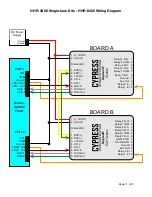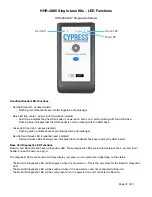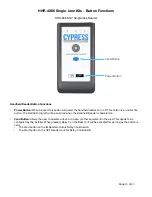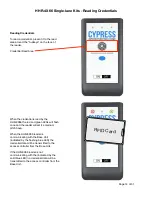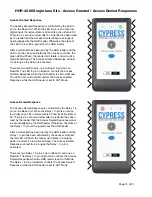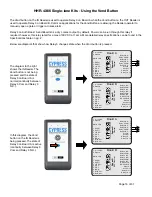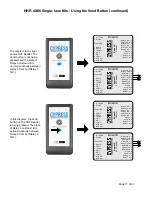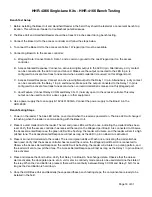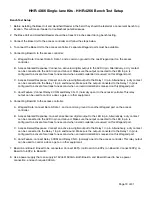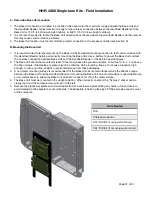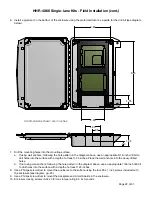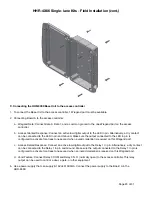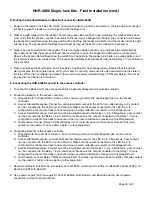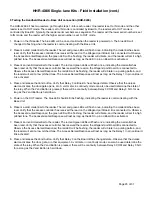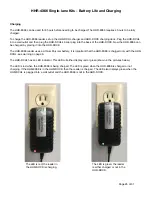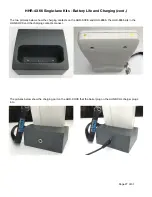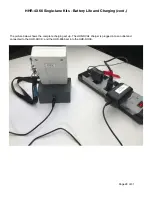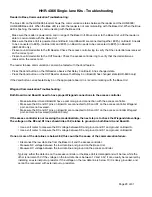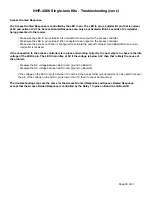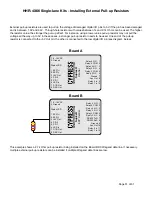
Page of
25
31
HHR-4X66 Single-lane Kits - Field Installation
(cont.)
F. Testing the Handheld Reader-to-Base Unit connection (HHR-8400)
The HHR-4266 kit has two readers, go through steps 1-8 for each reader. One reader is set to IN mode and the other
reader is set to OUT mode. The reader set to IN mode is controlled by Board A, the reader set to OUT mode is
controlled by Board B. Typically, the reader serial numbers are sequential. The reader will the lower serial number is set
to IN mode, and the reader with the higher serial number is set to OUT mode.
1. Power on the IN reader. The blue LED will be on and solid when the reader is powered on. The blue LED will
changed to flashing when the reader is communicating with the Base Unit.
2. Present a valid credential to the reader. The red and green LEDs will flash once, indicating the credential has been
read. Verify that the access controller has received the read on the Wiegand port Board A is connected to. Observe
the Access Granted Response; the green LED will be flashing, the reader will vibrate, and the reader will emit a high
pitched tone. The Access Granted Response will last as long as the LED In pin on Board A is activated.
3. Present an invalid credential to the reader. The red and green LEDs will flash once, indicating the credential has
been read. Verify that the access controller has received the read on the Wiegand port Board A is connected to.
Observe the Access Denied Response; the red LED will be flashing, the reader will vibrate in a pulsing pattern, and
the reader will emit a low pitched tone. The Access Denied Response will last as long as the Relay 1 In pin on Board
A is activated.
4. Press and release the Vend button. Verify that Relay 3 on Board A has changed state. Observe that the duress
alarm activates, the door/gate opens, etc. A volt meter in continuity mode can also be used determine the state of
the relay. When the Vend Button is pressed, there will be continuity between Relay 3 COM and Relay 3 N.O. for as
long as the Vend Button is held down.
5. Power on the OUT reader. The blue LED should still be flashing, indicating the reader is communicating with the
Base Unit.
6. Present a valid credential to the reader. The red and green LEDs will flash once, indicating the credential has been
read. Verify that the access controller has received the read on the Wiegand port Board B is connected to. Observe
the Access Granted Response; the green LED will be flashing, the reader will vibrate, and the reader will emit a high
pitched tone. The Access Granted Response will last as long as the LED In pin on Board B is activated.
7. Present an invalid credential to the reader. The red and green LEDs will flash once, indicating the credential has
been read. Verify that the access controller has received the read on the Wiegand port Board B is connected to.
Observe the Access Denied Response; the red LED will be flashing, the reader will vibrate in a pulsing pattern, and
the reader will emit a low pitched tone. The Access Denied Response will last as long as the Relay 1 In pin on Board
B is activated.
8. Press and release the Vend button. Verify that Relay 3 on the Board B has changed state. Observe that the duress
alarm activates, the door, gate, or other equipment. A volt meter in continuity mode can also be used determine the
state of the relay. When the Vend Button is pressed, there will be continuity between Relay 3 COM and Relay 3 N.O.
for as long as the Vend Button is held down.

